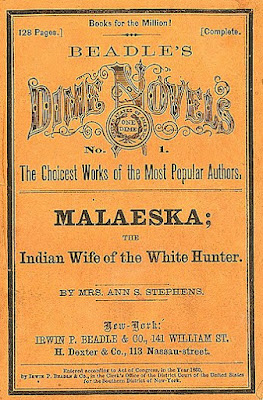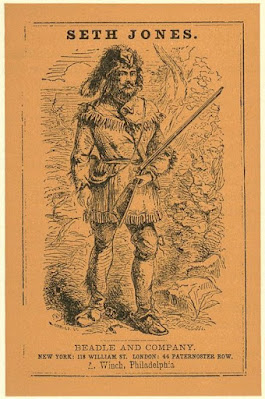By Jennifer Uhlarik
Howdy, readers! I’m back to share another interesting tidbit of my research from my upcoming release, Love and Order: A Three-Part Old West Romantic Mystery. This month, I thought I’d share about the research I did for the character of Lucinda Peters. This spunky heroine is a dime novelist and aspiring newspaper reporter. Have you heard of dime novels? If not, let me share what these were.
Around the time of the American Civil War, the literacy rate in this country began to grow. In response to the uptick of readers in America, people began looking for easily accessible material to read. Publishers Erastrus and Irwin Beadle met that need when, in 1860, they began releasing a new series of fiction novels, printed in inexpensive paperback formats, and sold for ten cents each. The topics of these novels most often centered around America’s western frontier—stories about the Gold Rush and/or mining camps; building of the railroad; lawmen, outlaws, and other notable characters of the frontier; and many other such topics.
 |
| The first Dime Novel, published in 1860. Note the lack of cover artwork. |
The first of these “dime novels” was a reprint of a serialized story written by Ann S. Stephens (who went on to author many of Beadle’s dime novels), titled Malaeska, the Indian Wife of the White Hunter. This serialized story first appeared some twentyish years earlier in the Ladies’ Companion magazine, so the material was old enough that most people wouldn’t immediately recognize it as a reprinted story. It came wrapped in a salmon-colored paper, with no artwork on the cover—only the title. However, in its new format as a dime novel, this story of roughly 100 pages sold around 65,000 copies in its first several months. It was a hit!

Another early example of a
dime novel, this time with
cover artwork.
Because of this early success, Beadle, along with Ann Stephens, went on to reprint more of her older, serialized stories. And as this new series grew in popularity, the publisher had Stephens write new, original material for their novels as well. With the quick success of the Beadle’s Dime Novel series, particularly with the younger readers, other publishers followed in their footsteps. By the end of the Civil War, there were all manner of publishers putting out their own versions of the dime novels. Each publisher had their own style—the dimensions of their books might be a little different, and one company’s covers might have black-and-white artwork while another company’s cover sported only the title. At first, each was sold with a colored outer wrapping—a different color for each publisher, but as time went on and printing technology became better, the covers changed to color printing on white paper. Also, the topics covered began to grow. Not only were they stories of the American frontier—but also historical romances, science fiction, mysteries, war stories, adventure stories, and more. Interestingly, dime novels were often authored by women.
 |
| Dime novel with a color cover. |
Dime novels quickly developed a reputation as not being of the greatest literary quality. In fact, many in polite society frowned on this form of cheap entertainment. The stories were churned out quickly, and the writing wasn’t always of the highest quality. Within the stories themselves, the exploits of the characters were often exaggerated, making the lawmen sound more righteous or the outlaws more villainous than they truly were. Often, the storylines covered only the most superficial aspects without getting to the true depths of the real story. So many of the highbrow folks in society took the view that these cheap novels contributed to the degradation of their society.
Despite the poor view many held of this literary form, dime novels endured in popularity for decades. The original dime novel series from Beadle was published from 1860 until sometime in the 1920s. The company published 321 issues in its sixtyish-year run. The many other publishers also continued into the first few decades of the 1900s, but the fad finally died out around 1925.

A later version of the
dime novel.
A resurgence of interest in these early novels came in the 1940s and lasted into the 1950s. People began buying up old copies to add to collections they—or their parents and grandparents—had saved. Because of the very cheap paper these stories were printed on, they were often in fragile condition. Today, in 2025, there are still thousands in existence—but most are held in the Library of Congress, in collections at various universities around the country, or sometimes in the collections of museums or historical centers. Because of the fading quality of the papers, some collections have been digitized and are available online. To see one such collection, check out Nickels & Dimes.
It's Your Turn: Had you heard of dime novels? If you had lived in the time when they were popular, do you suppose you would have read them—or would you have seen them as bad for society? Leave your answer with your email address to be entered in a giveaway of a paperback copy of Love and Order: A Three-Part Old West Romantic Mystery. (U.S. Residents only, please).
Jennifer Uhlarik discovered western novels at twelve when she swiped the only “horse” book from her brother’s bookshelf. Across the next decade, she devoured westerns and fell in love with the genre. While attaining a B.A. in writing from the University of Tampa, she began penning her own story of the Old West. She has finaled in and won numerous writing competitions and appeared on various best-seller lists. Besides writing, she’s been a business owner, a schoolteacher, a marketing director, a historical researcher, a publisher, and a full-time homemaker. She lives near Tampa, Florida, with her husband and fur children.
Love and Order: A Three-Part Old West Romantic Mystery (coming April 1, 2025)
Wanted: Family, Love, and Justice
One Old West Mystery Solved Throughout Three Short Romantic Stories
Separated as children when they were adopted out to different families from an orphan train, the Braddock siblings have each grown up and taken on various jobs within law enforcement and criminal justice.
Youngest child, Callie, has pushed past her insecurities to pursue a career as a Pinkerton agent. Middle child, Andi, has spent years studying law under her adoptive father’s tutelage. And the eldest and only son, Rion, is a rough-and-tumble bounty hunter.
When the hunt for a serial killer with a long history of murders reunites the brother and sisters in Cambria Springs, Colorado, they find themselves not only in a fight for justice, but also a fight to keep their newly reunited family intact. How will they navigate these challenges when further complicated by unexpected romances?




I had heard of dime novels but didn't know much about their history. Thank you...this was fascinating! I'd love a chance to win Love and Order. hmcid at hotmail dot com
ReplyDeleteThank you for posting today. I have heard of dime novels, but didn't realize they began so early. Thank you for the giveaway chance. bcrug at twc dot com
ReplyDeleteMy brother has several of the old dime novels in his collection. Thank you for the chance to win your book, Jennifer. jenningskaren1973 at gmail dot com
ReplyDeleteIf I was the avid reader I am today I probably would have read them. Books were precious and not cheap. Libraries were not easily accessible to rural areas. Local merchants kept a selection of books especially dime novels for sale. You have my email address.
ReplyDeleteCongratulations, Jubileewriter! You won the drawing for a copy of Love and Order. Cindy, I'll contact you privately for your address.
ReplyDelete